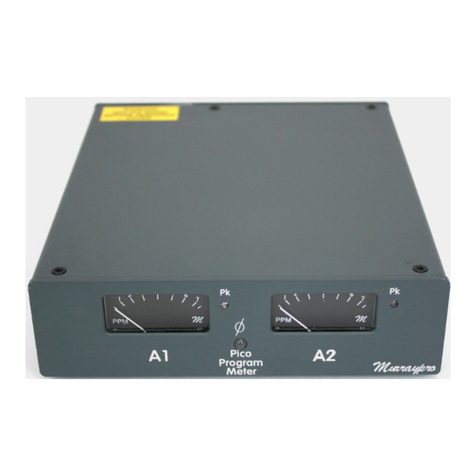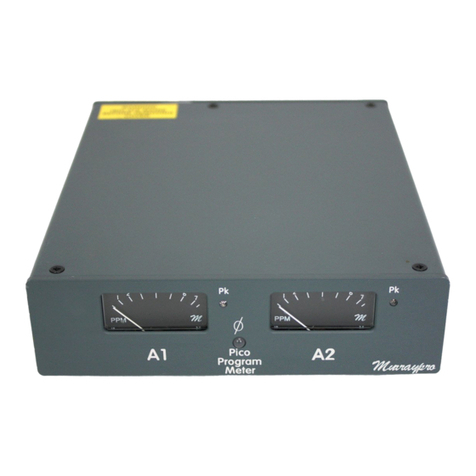
Test Chest: Manual
1) Which-Wire?
Which-Wire? is an exceptionally powerful investigative tool in which Test
Chest emulates our earlier Murraypro 'Which-Wire?' Unit, and itis not even
necessaryto ‘manually’ power the Unit up for operation inthis mode.As soon as a
signal is appliedto the 'Which-Wire?' input Test Chest automaticallyawakens,
determines it’s signal format, automaticallyselectingtheoptimummanner to display
the detected signal, whether it be TV monitor, WFM,or asan audio histogram.
AdditionallyifaTV signal is detected,it identifiesthe source's TV Standard as 3G-
SDI, HD-SDI, SD-SDI, CVBS, together with it's Frame Rate,which is reported on a
Banner atthe top of the 16:9 LCD screen.
“W-W?” capabilityincludes 'Tri-Level' and
'Colour Black' Sync detection.Either sync signal is
displayed in the WFM's 'H Expand' mode.
“W-W?” capabilityon BNC1 includes the
detection ofUNBALANCED AES andSPDIF sources.
When present, the LCD displayautomatically selects
AES mode on the 'Audio Monitoring' page.
“W-W?” detection mode has beenextended to now
include High Definition Video Interfacesources which are applied
to the connector twixtBNC1 & 2.When detected, HDVIimages
@TV relatedscanrates will be displayed, sources onother
standards will be detected, butmaynot be coherentlypresented.
Users shouldconnecttheir 'mysteryIP signal' to the lowest BNC connector,
BNC1, designated“WW?” at the bottomright ofthe frontpanel. This connector
always terminates the inputwith 75W, so it is never necessaryto provide a separate
external termination. The fundamental feature of Which-Wire? Mode is that CVBS,
SDI and AES signals enter the Unit via the same connector.It is never necessaryto
double guess what signal maybe presenton a given cable, asthe Test Chest will
automaticallyswitch tothe appropriateDigital, Analogue, AES or Tri-level/Composite
sync mode, as required to correctlydisplaythe detected input which nowincludes
HDVI signals with TV related imageformats.
It is vital to appreciate that “Which-Wire?” mode can ONLY beinitiatedwith
the Test Chest un-powered, it cannot function when the Test Chest is already
powered upas it will already be in a ‘manually’ selected operating mode!
Followinga ‘manual’ power-up, the main menu is presentedfromwhich the
User selects ‘TV’, WFM’ or ‘Audio’ mode asrequired. ~ Let us assume ‘TV’ mode is
manuallyselected, so applyinga TVsignal tothe “W-W?” input will indeed display
an immediate picture, and infact this will be even faster thanfromquiescent, as the
Unit is alreadypowered, BUTit can’t identify Tri-level sync, or AES audio for
example, nor displaythese in anymeaningful manner in TV Monitor mode, as this
doesn’t offer any'WFM display' or AES measurement capability!





























